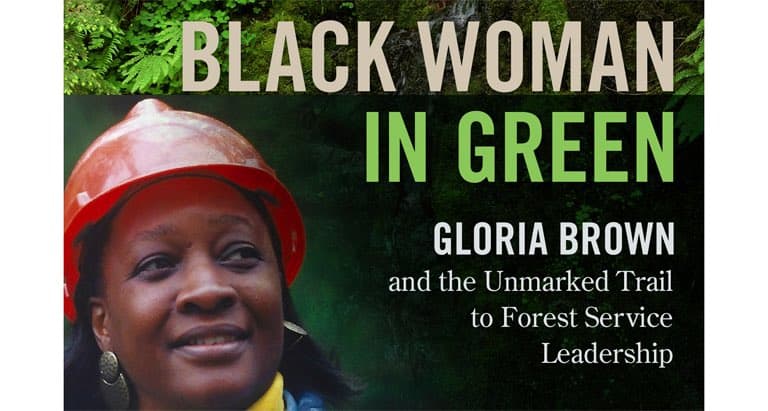Steve Wilent was kind enough to let me review this book for the Forestry Source. I’ve edited it a bit for TSW. Note that TSW welcomes book reviews.
Black Woman in Green: Gloria Brown and the Unmarked Trail to Forest Service Leadership
Authors: Gloria D. Brown and Donna L. Sinclair
Foreword by Laurie Mercier.
Published by Oregon State University Press, 2020. Paperback, ISBN 978-0-87071-001-8.
$19.95. E-book, ISBN 978-0-87071-005-6, $11.99. Available at tinyurl.com/ych94z7t.
Black Woman in Green: Gloria Brown and the Unmarked Trail to Forest Service Leadership is an autobiography of Gloria Brown, covering her early life and her career in the Forest Service.
Brown was one of the first black women in the Forest Service, in a time when the agency employed few women professionals and few African Americans. She also was the agency’s first
female African American forest supervisor. Brown had to prove herself over and over, and in addition to racism and sexism, she had two more Forest Service cultural handicaps. She had gotten her start not on a ranger district, but in the Washington Office (at the time, it was thought that everyone should start on a ranger district). Her first job was as a GS-4 dictating machine transcriber; she later worked in the Forest Service Office of Information and Education (she began in the “wrong” series, and only received a natural resources degree later). In those days, being accepted meant having certain characteristics and following a certain path. Brown survived, thrived, and was highly successful, in spite of not being very different from the tradition of the time, through her own determination, hard work, smarts, and a network of relationships. If you wonder, “How did she pull that off?” or think, “Maybe I could learn something,” then this book is for you.
Brown traveled many of the same paths and met many of the same people as I did in my career. FS graduates like me will take particular enjoyment from Brown’s take on familiar people
and issues, whether we agree or not. For that reason, I found the book hard to put down. It’s only 175 pages, and I read most of it in one sitting, wanting to see what happened next. There are also
handy footnotes and an index.
For current employees, there are lessons that may well be as relevant today as when Brown learned them. Lessons from her early days: her own perspective on racism in the workforce and in the community, and how that affected her and her family. We learn what kind of support made a difference to her in trying times. Brown includes her insights into how anyone can thrive in the Forest Service. For example, she learned to find people to work for who had a track record of hiring people who then went on to better positions. She discovered the power of intent coupled with strategy. She also learned—the hard way—about not going over people’s heads.
Along the way, Brown developed an amazing network of supporters. She relentlessly went after new positions and promotions, all the way to her ultimate goal of forest supervisor; she served in that role on both the Siuslaw and Los Padres National Forests. Brown dealt with budget crises and low morale after agency downsizing. She describes these in enough detail that it’s a bit like listening to stories from a mentor.
What Forest Service observers from outside the agency might find interesting are how the Forest Service dealt with one of the first black female leaders- how aspects of the culture worked for her and against her. Observers might also be interested in the “behind the scenes” looks at how employees work together to produce decisions, and the role of line officers or deciding officials. When Brown moved to a new position, she learned to make decisions after first discussing the issues with her staff and listing to the concerns of the public. She gives some examples of how she found solutions that respected different points of view, including those of different politicians, communities, and other stakeholders, and how she developed positive working relationships with groups and individuals outside of the Forest Service and the BLM.
While much of the book describes her experiences during the “timber wars” in western Oregon, she also describes a Bureau of Land Management job in DC, her time working for the BLM in
eastern Oregon, and working as manager of the Mount St. Helen’s National Monument in Washington State.
Throughout the book, Brown shares her own experiences as a girl growing up, a wife, and a mother, and explains how she wove her personal and professional lives together to make a complete life. Her experience as one of the “firsts” was challenging and difficult, and she shares the joys and sorrows of her journey.
From the epilogue:
The song “Time of My Life” sums up my career with the Forest Service. Forest Service took my heart and soul and turned me into someone I could have never imagined. I am grateful for that.
Working for the Forest Service was never easy, but it was challenging, rewarding, and, more often than not, a lot of fun! I would say to anyone—woman, person of color, person identifying
as LGBTQ, or person with physical challenges—join the Forest Service and splash into a career unlike anything you can imagine. That’s what I did.
Thank you for your service, Gloria Brown!

I worked with Gloria when she was on the MSHNVM – thanks for sharing her new book!